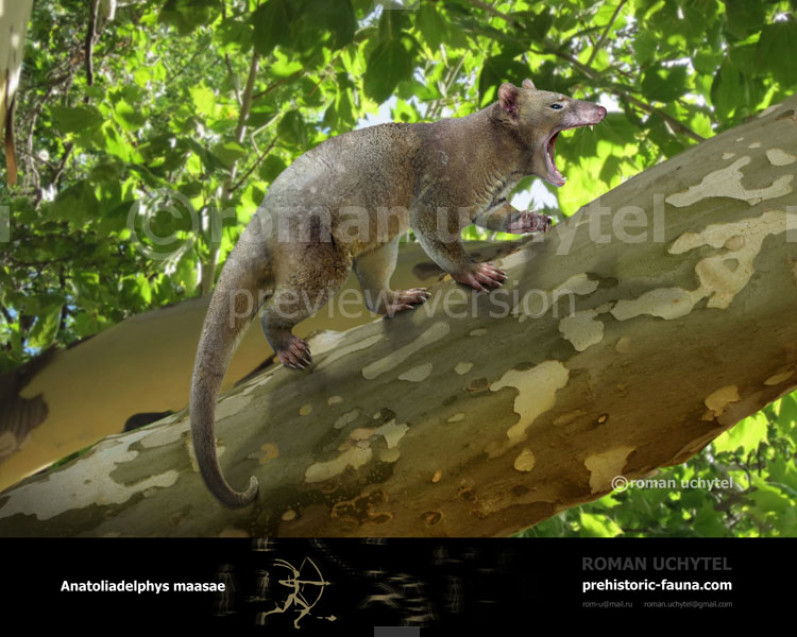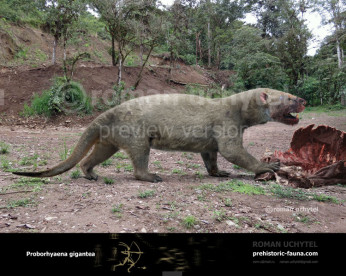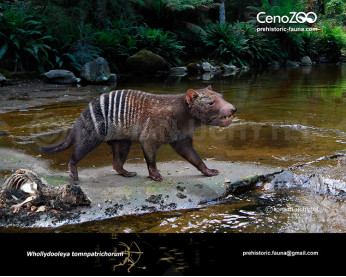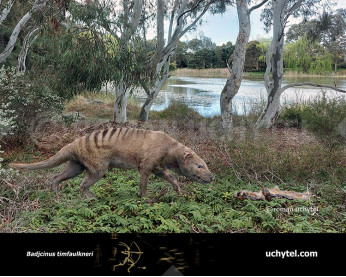Anatoliadelphys maasae
343343Skeleton of an unusual, cat-sized marsupial relative (Metatheria: Marsupialiformes) from the middle Eocene (Lutetian: 44-43 million years ago) of Turkey
We describe a near-complete, three-dimensionally preserved skeleton of a metatherian (relative of modern marsupials) from the middle Eocene (Lutetian: 44–43 million years ago) Lülük member of the Uzunçarşıdere Formation, central Turkey. With an estimated body mass of 3–4 kg, about the size of a domestic cat (Felis catus) or spotted quoll (Dasyurus maculatus), it is an order of magnitude larger than the largest fossil metatherians previously known from the Cenozoic of the northern hemisphere. This new taxon is characterised by large, broad third premolars that probably represent adaptations for hard object feeding (durophagy), and its craniodental morphology suggests the capacity to generate high bite forces. Qualitative and quantitative functional analyses of its postcranial skeleton indicate that it was probably scansorial and relatively agile, perhaps broadly similar in locomotor mode to the spotted quoll, but with a greater capacity for climbing and grasping. Bayesian phylogenetic analysis of a total evidence dataset comprising 259 morphological characters and 9kb of DNA sequence data from five nuclear protein-coding genes, using both undated and “tip-and-node dating” approaches, place the new taxon outside the marsupial crown-clade, but within the clade Marsupialiformes. It demonstrates that at least one metatherian lineage evolved to occupy the small-medium, meso- or hypo-carnivore niche in the northern hemisphere during the early Cenozoic, at a time when there were numerous eutherians (placentals and their fossil relatives) filling similar niches. However, the known mammal fauna from Uzunçarşıdere Formation appears highly endemic, and geological evidence suggests that this region of Turkey was an island for at least part of the early Cenozoic, and so the new taxon may have evolved in isolation from potential eutherian competitors. Nevertheless, the new taxon reveals previously unsuspected ecomorphological disparity among northern hemisphere metatherians during the first half of the Cenozoic.
http://journals.plos.org/plosone/article?id=10.1371/journal.pone.0181712
Skeleton of an unusual, cat-sized marsupial relative (Metatheria: Marsupialiformes) from the middle Eocene (Lutetian: 44-43 million years ago) of Turkey
We describe a near-complete, three-dimensionally preserved skeleton of a metatherian (relative of modern marsupials) from the middle Eocene (Lutetian: 44–43 million years ago) Lülük member of the Uzunçarşıdere Formation, central Turkey. With an estimated body mass of 3–4 kg, about the size of a domestic cat (Felis catus) or spotted quoll (Dasyurus maculatus), it is an order of magnitude larger than the largest fossil metatherians previously known from the Cenozoic of the northern hemisphere. This new taxon is characterised by large, broad third premolars that probably represent adaptations for hard object feeding (durophagy), and its craniodental morphology suggests the capacity to generate high bite forces. Qualitative and quantitative functional analyses of its postcranial skeleton indicate that it was probably scansorial and relatively agile, perhaps broadly similar in locomotor mode to the spotted quoll, but with a greater capacity for climbing and grasping. Bayesian phylogenetic analysis of a total evidence dataset comprising 259 morphological characters and 9kb of DNA sequence data from five nuclear protein-coding genes, using both undated and “tip-and-node dating” approaches, place the new taxon outside the marsupial crown-clade, but within the clade Marsupialiformes. It demonstrates that at least one metatherian lineage evolved to occupy the small-medium, meso- or hypo-carnivore niche in the northern hemisphere during the early Cenozoic, at a time when there were numerous eutherians (placentals and their fossil relatives) filling similar niches. However, the known mammal fauna from Uzunçarşıdere Formation appears highly endemic, and geological evidence suggests that this region of Turkey was an island for at least part of the early Cenozoic, and so the new taxon may have evolved in isolation from potential eutherian competitors. Nevertheless, the new taxon reveals previously unsuspected ecomorphological disparity among northern hemisphere metatherians during the first half of the Cenozoic.
http://journals.plos.org/plosone/article?id=10.1371/journal.pone.0181712




